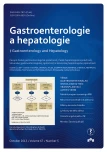Uncommon indications for orthotopic liver transplantation
Authors:
H. Gottfriedová 1; P. Trunečka 2; L. Janečková 1; V. Lánská 3; J. Špičák 1
Authors‘ workplace:
Klinika hepatogastroenterologie, IKEM, Praha
1; Transplantcentrum, IKEM, Praha
2; Oddělení lékařské statistiky, IKEM, Praha
3
Published in:
Gastroent Hepatol 2013; 67(5): 421-425
Category:
Hepatology: Original Article
Overview
As of 13th August 2013, 1,000 liver transplants have been carried out at the Institute for Clinical and Experimental Medicine (IKEM) in Prague of which in 84 (8.4%) cases for an uncommon diagnosis. Indicating the process in these cases is more difficult than in conventional diagnoses, because there is insufficient experience and the results are evaluated on small samples of patients.
Methods:
A retrospective review of a group of patients with less frequent diagnoses who underwent orthotopic liver transplantation in IKEM. For selected diagnoses, we assessed the cumulative survival of patients and grafts.
Results:
The most frequent diagnoses were polycystic liver disease, Budd-Chiari syndrome and epithelioid hemangioendothelioma. Annual cumulative survival reached 87%, 82%, 100%; five-year survival was 87%, 72% and 100%. In the group of six subjects transplanted for metastatic neuroendocrine tumours in the liver two patients died.
Conclusion:
In the indicated cases, orthotopic liver transplantation brings excellent results in the group of uncommon diagnoses. Patients with metastases of neuroendocrine tumours in the liver represent a borderline indication. Orthotopic liver transplantation can be a good solution for some rare conditions. To succeed it is essential to carry out a careful pre-transplantation evaluation and examination. We have to always consider the possibility of a conservative treatment.
Key words:
liver transplantation – uncommon indications – patient and graft survival
The authors declare they have no potential conflicts of interest concerning drugs, products, or services used in the study.
The Editorial Board declares that the manuscript met the ICMJE „uniform requirements“ for biomedical papers.
Submitted:
20. 8. 2013
Accepted:
23. 9. 2013
Sources
1. Trunečka P, Vítko Š, Adamec M et al. Výsledky programu transplantace jater v IKEM za 10 let trvání. Folia Gastroenterol Hepatol 2005; 3 (Suppl 1): 13–21.
2. Keeffe EB. Selection of patients for liver transplantation. In: Maddrey WC, Sorrell MF, Schiff ER (eds). Transplantation of the liver. 3rd ed. Philadelphia: Lippincott Williams & Wilkins 2001 : 5–34.
3. Lerut JP,Orlando G, Sempoux C et al. Hepatic haemangioendothelioma in adults: excellent outcome following liver transplantation. Transpl Int 2004; 17(4): 202–207.
4. Agrawal N, Parajuli S, Zhao P et al. Liver transplantation in the management of hepatic epithelioid hemangioendothelioma: a single-center experience and review of the literature. Transplant Proc 2011; 43(7): 2647–2650.
5. Everson GT. Polycystic liver disease. Gastroenterol Hepatol (N Y) 2008; 4(3): 179–181.
6. Sutcliffe R, Maguire D, Ramage J et al. Management of neuroendocrine liver metastases. Am J Surg 2004; 187(1): 39–46.
7. Gores GJ, Heimbach JK, Rosen CB. Liver transplantation for non-hepatocellular carcinoma malignancies. Liver Transpl 2010; 16 (10 Suppl 2): S22–S25.
8. Mergental H, Adam R, Ericzon BG et al. Liver transplantation for unresectable hepatocellular carcinoma in normal livers. J Hepatol 2012; 57(2): 297–305.
9. Kirchner GI, Rifai K, Cantz T. Outcome and quality of life in patients with polycystic liver disease after liver or combined liver-kidney transplantation. Liver Transpl 2006; 12(8): 1268–1277.
Labels
Paediatric gastroenterology Gastroenterology and hepatology SurgeryArticle was published in
Gastroenterology and Hepatology

2013 Issue 5
Most read in this issue
- Picoprep – a cleansing agent with dual effect
- Small intestine lymphomas
- Liver transplantation for primary sclerosing cholangitis
- Hereditary diffuse gastric cancer
